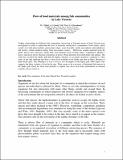Flow of food materials among fish communities in Lake Victoria
Author
Date
2004Type
Articleviews
downloads
Metadata
Show full item recordxmlui.dri2xhtml.METS-1.0.item-citation
Flow of food materials among fish communities in Lake Victoria H. A. Mhitu1, A. I. Chande2 , R.K. Waya3 J.A. Mwambungu4. 1TAFIRI, P.O. Box 78850, Dar es Salaam, Tanzania
Abstract/
Trophic relationships for different fish communities interacting in Tanzania waters of Lake Victoria were investigated in order to understand the flow of materials among those communities. Food chains, which usually start with photosynthetic green plants (algae, water hyacinth, Azolla, macrophytes, phytoplankton) and protists, obtain chemical energy from non-organic sources. Herbivores acquire materials from the plants and in turn carnivores obtain their food materials from juvenile fishes, zooplankton, Molluscs, insects and insect larvae. Bacteria (organisms of decay) obtain materials from dead plants and animals. The study has revealed that Speke gulf had the highest densities of secondary producers compared to other zones of the lake implying that there is more food available in the Speke gulf than in Mara, Mwanza or Emin Pasha gulfs. The abundance of Lates niloticus was the highest in the Speke gulf (190.4 kg/h). This suggests that there is plenty of food in the area. There seems to be a recovery of threatened fish species in the Speke gulf which has been used partially to explain why those food items predominate in stomach contents of Lates niloticus.

